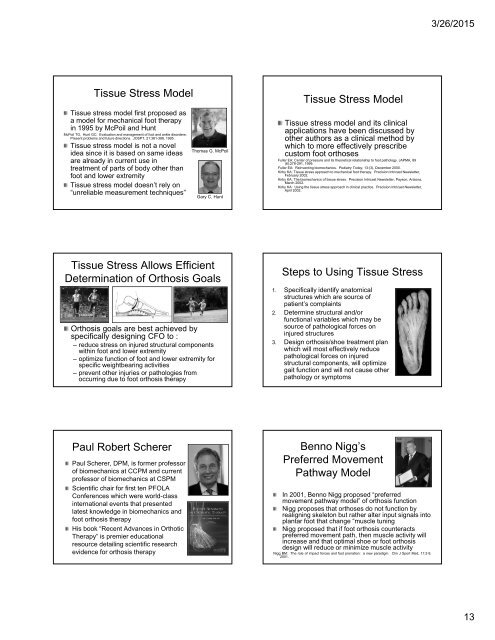History-Evolution-of-Foot-and-Lower-Extremity-Biomechanics-and-Foot-Orthoses_Kevin-Kirby
History-Evolution-of-Foot-and-Lower-Extremity-Biomechanics-and-Foot-Orthoses_Kevin-Kirby
History-Evolution-of-Foot-and-Lower-Extremity-Biomechanics-and-Foot-Orthoses_Kevin-Kirby
Create successful ePaper yourself
Turn your PDF publications into a flip-book with our unique Google optimized e-Paper software.
3/26/2015<br />
Tissue Stress Model<br />
Tissue stress model first proposed as<br />
a model for mechanical foot therapy<br />
in 1995 by McPoil <strong>and</strong> Hunt<br />
McPoil TG, Hunt GC: Evaluation <strong>and</strong> management <strong>of</strong> foot <strong>and</strong> ankle disorders:<br />
Present problems <strong>and</strong> future directions. JOSPT, 21:381-388, 1995.<br />
Tissue stress model is not a novel<br />
idea since it is based on same ideas<br />
are already in current use in<br />
treatment <strong>of</strong> parts <strong>of</strong> body other than<br />
foot <strong>and</strong> lower extremity<br />
Tissue stress model doesn’t rely on<br />
“unreliable measurement techniques”<br />
Thomas G. McPoil<br />
Gary C. Hunt<br />
Tissue Stress Model<br />
Tissue stress model <strong>and</strong> its clinical<br />
applications have been discussed by<br />
other authors as a clinical method by<br />
which to more effectively prescribe<br />
custom foot orthoses<br />
Fuller EA: Center <strong>of</strong> pressure <strong>and</strong> its theoretical relationship to foot pathology. JAPMA, 89<br />
(6):278-291, 1999.<br />
Fuller EA: Reinventing biomechanics. Podiatry Today, 13:(3), December 2000.<br />
<strong>Kirby</strong> KA: Tissue stress approach to mechanical foot therapy. Precision Intricast Newsletter,<br />
February 2002.<br />
<strong>Kirby</strong> KA: The biomechanics <strong>of</strong> tissue stress. Precision Intricast Newsletter, Payson, Arizona,<br />
March 2002.<br />
<strong>Kirby</strong> KA: Using the tissue stress approach in clinical practice. Precision Intricast Newsletter,<br />
April 2002.<br />
Tissue Stress Allows Efficient<br />
Determination <strong>of</strong> Orthosis Goals<br />
Orthosis goals are best achieved by<br />
specifically designing CFO to :<br />
– reduce stress on injured structural components<br />
within foot <strong>and</strong> lower extremity<br />
– optimize function <strong>of</strong> foot <strong>and</strong> lower extremity for<br />
specific weightbearing activities<br />
– prevent other injuries or pathologies from<br />
occurring due to foot orthosis therapy<br />
Steps to Using Tissue Stress<br />
1. Specifically identify anatomical<br />
structures which are source <strong>of</strong><br />
patient’s complaints<br />
2. Determine structural <strong>and</strong>/or<br />
functional variables which may be<br />
source <strong>of</strong> pathological forces on<br />
injured structures<br />
3. Design orthosis/shoe treatment plan<br />
which will most effectively reduce<br />
pathological forces on injured<br />
structural components, will optimize<br />
gait function <strong>and</strong> will not cause other<br />
pathology or symptoms<br />
Paul Robert Scherer<br />
Paul Scherer, DPM, is former pr<strong>of</strong>essor<br />
<strong>of</strong> biomechanics at CCPM <strong>and</strong> current<br />
pr<strong>of</strong>essor <strong>of</strong> biomechanics at CSPM<br />
Scientific chair for first ten PFOLA<br />
Conferences which were world-class<br />
international events that presented<br />
latest knowledge in biomechanics <strong>and</strong><br />
foot orthosis therapy<br />
His book “Recent Advances in Orthotic<br />
Therapy” is premier educational<br />
resource detailing scientific research<br />
evidence for orthosis therapy<br />
Benno Nigg’s<br />
Preferred Movement<br />
Pathway Model<br />
In 2001, Benno Nigg proposed “preferred<br />
movement pathway model” <strong>of</strong> orthosis function<br />
Nigg proposes that orthoses do not function by<br />
realigning skeleton but rather alter input signals into<br />
plantar foot that change “muscle tuning<br />
Nigg proposed that if foot orthosis counteracts<br />
preferred movement path, then muscle activity will<br />
increase <strong>and</strong> that optimal shoe or foot orthosis<br />
design will reduce or minimize muscle activity<br />
Nigg BM: The role <strong>of</strong> impact forces <strong>and</strong> foot pronation: a new paradigm. Clin J Sport Med, 11:2-9,<br />
2001.<br />
13


